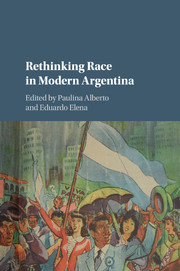Book contents
- Frontmatter
- Contents
- List of figures
- List of tables
- Notes on the contributors
- Preface
- Introduction: The shades of the nation
- PART I HISTORIES OF RACE IN THE TWENTIETH CENTURY
- 1 Insecure whiteness: Jews between civilization and barbarism, 1880s–1940s
- 2 People as landscape: The representation of the criollo Interior in early tourist literature in Argentina, 1920–30
- 3 Black in Buenos Aires: The transnational career of Oscar Alemán
- 4 La cocina criolla: A history of food and race in twentieth-century Argentina
- 5 “Invisible Indians,” “degenerate descendants”: Idiosyncrasies of mestizaje in Southern Patagonia
- 6 Race and class through the visual culture of Peronism
- 7 Argentina in black and white: Race, Peronism, and the color of politics, 1940s to the present
- PART II RACE AND NATION IN THE NEW CENTURY
- Epilogue: Whiteness and its discontents
- Collective bibliography
- Index
6 - Race and class through the visual culture of Peronism
from PART I - HISTORIES OF RACE IN THE TWENTIETH CENTURY
Published online by Cambridge University Press: 05 March 2016
- Frontmatter
- Contents
- List of figures
- List of tables
- Notes on the contributors
- Preface
- Introduction: The shades of the nation
- PART I HISTORIES OF RACE IN THE TWENTIETH CENTURY
- 1 Insecure whiteness: Jews between civilization and barbarism, 1880s–1940s
- 2 People as landscape: The representation of the criollo Interior in early tourist literature in Argentina, 1920–30
- 3 Black in Buenos Aires: The transnational career of Oscar Alemán
- 4 La cocina criolla: A history of food and race in twentieth-century Argentina
- 5 “Invisible Indians,” “degenerate descendants”: Idiosyncrasies of mestizaje in Southern Patagonia
- 6 Race and class through the visual culture of Peronism
- 7 Argentina in black and white: Race, Peronism, and the color of politics, 1940s to the present
- PART II RACE AND NATION IN THE NEW CENTURY
- Epilogue: Whiteness and its discontents
- Collective bibliography
- Index
Summary
The elites who built Argentina claimed that their nation was embodied in a white-European people. At the end of the nineteenth century, members of distinct African or indigenous groups were declared extinct or were acknowledged only as the last few historical remnants of their communities, rapidly dissolving in the massive torrent of European immigrants. Although a few dissident voices made themselves heard, the master narrative of the nation revolved around the idea of a “melting pot [crisol de razas]” out of which one unified and homogeneous new ethnos emerged. This new Argentine ethnos was almost exclusively connected (both culturally and biologically) to its European cradle, and the “Argentine race” was proclaimed to be “white.” This, of course, was a kind of fantasy, as the ethnic backgrounds and phenotypes of large portions of the population did not (and still do not) easily fit into standard definitions of whiteness. For one thing, Afro-Argentines and indigenous groups managed to preserve some ethnic particularities despite the state's homogenizing pressures. The continuity of their physical presence also posed challenges to assertions of whiteness. In addition, a large portion of the Argentine population with no sense of belonging to any particular ethnic minority bore phenotypes that did not fully align with contemporary images and stereotypes of whiteness. All Argentines were formally considered “white,” but in terms of physical appearance there was a substantial grey area between those who clearly displayed the right (“European”) skin tones and facial features, and those who obviously did not. In theory, Argentina's whiteness was one; but in practice it had its visual and social nuances.
Indeed, although Argentines of non-exclusively European ancestry have been rendered invisible through discourses of whiteness, racist aggressions against the lower classes have been present throughout modern Argentine history, particularly when plebeian sectors have acquired political representation. Both President Hipólito Yrigoyen's and Juan Perón's followers were discredited for being negros. Their capacity for citizenship was thus questioned, as the racial allusion evoked shortcomings traditionally associated with irrationality and barbarity. Moreover, as I have shown elsewhere, middle-class identity in Argentina developed around a particular historical narrative that imagined the middle class as a force for civilization and progress supposedly brought to the country by European immigration.
- Type
- Chapter
- Information
- Rethinking Race in Modern Argentina , pp. 155 - 183Publisher: Cambridge University PressPrint publication year: 2016
- 6
- Cited by



